Inuit Sculpture
From East to West - a powerful group of historic Inuit sculpture, from two collections, where each stone’s spirit is revealed through strength, sensitivity, and flowing form.
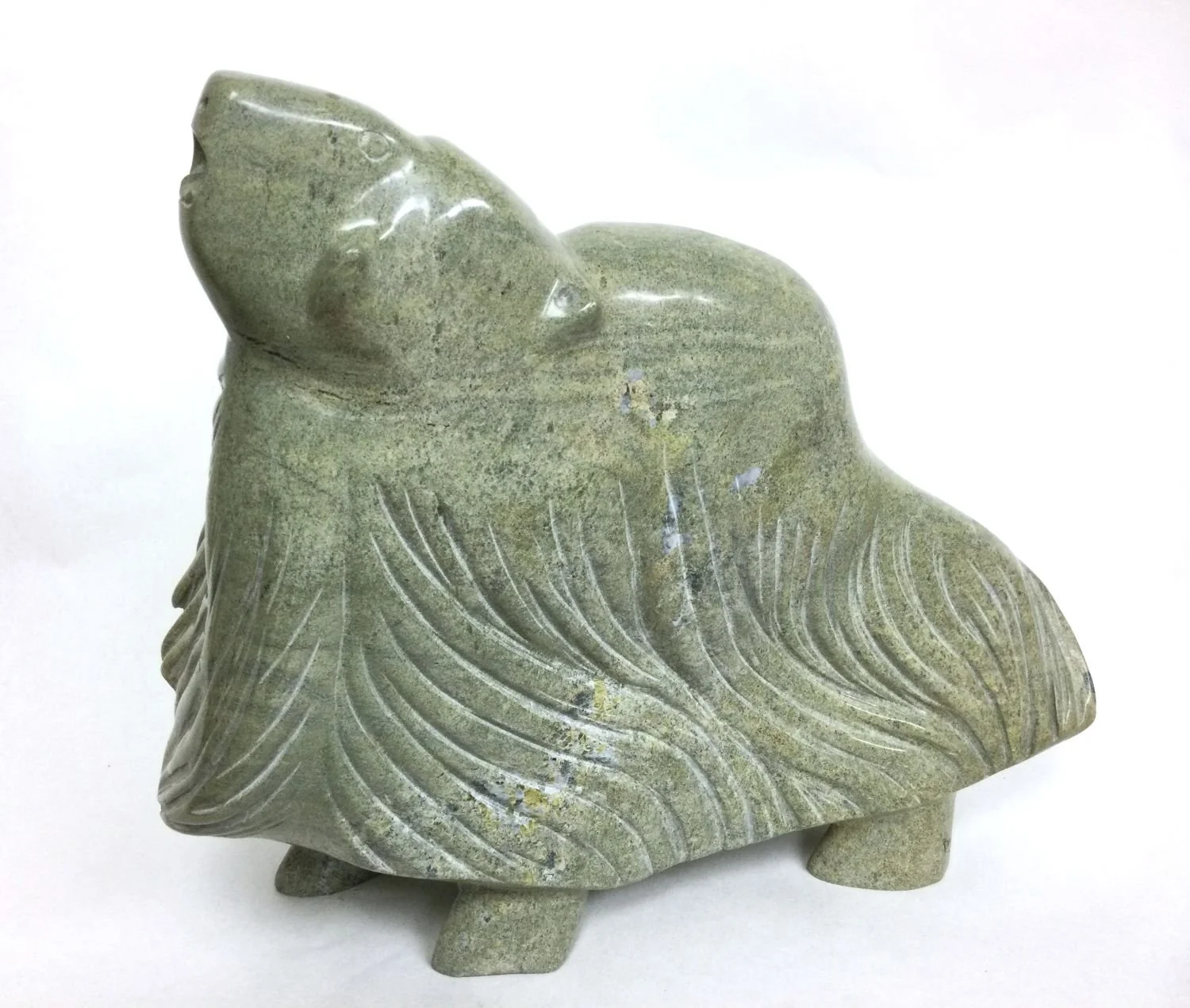
Kananginak Pootoogook ᑲᓇᖏᓈᖅ RCA (1935-2010), Cape Dorset/Kinngait, ᑭᙵᐃᑦ, MuskOx, c.1990, serpentine, 15 x 17 x 6.5 inches (37 x 49 x 15 cm), provenance: Canmore Collection, $18,000 Cdn.
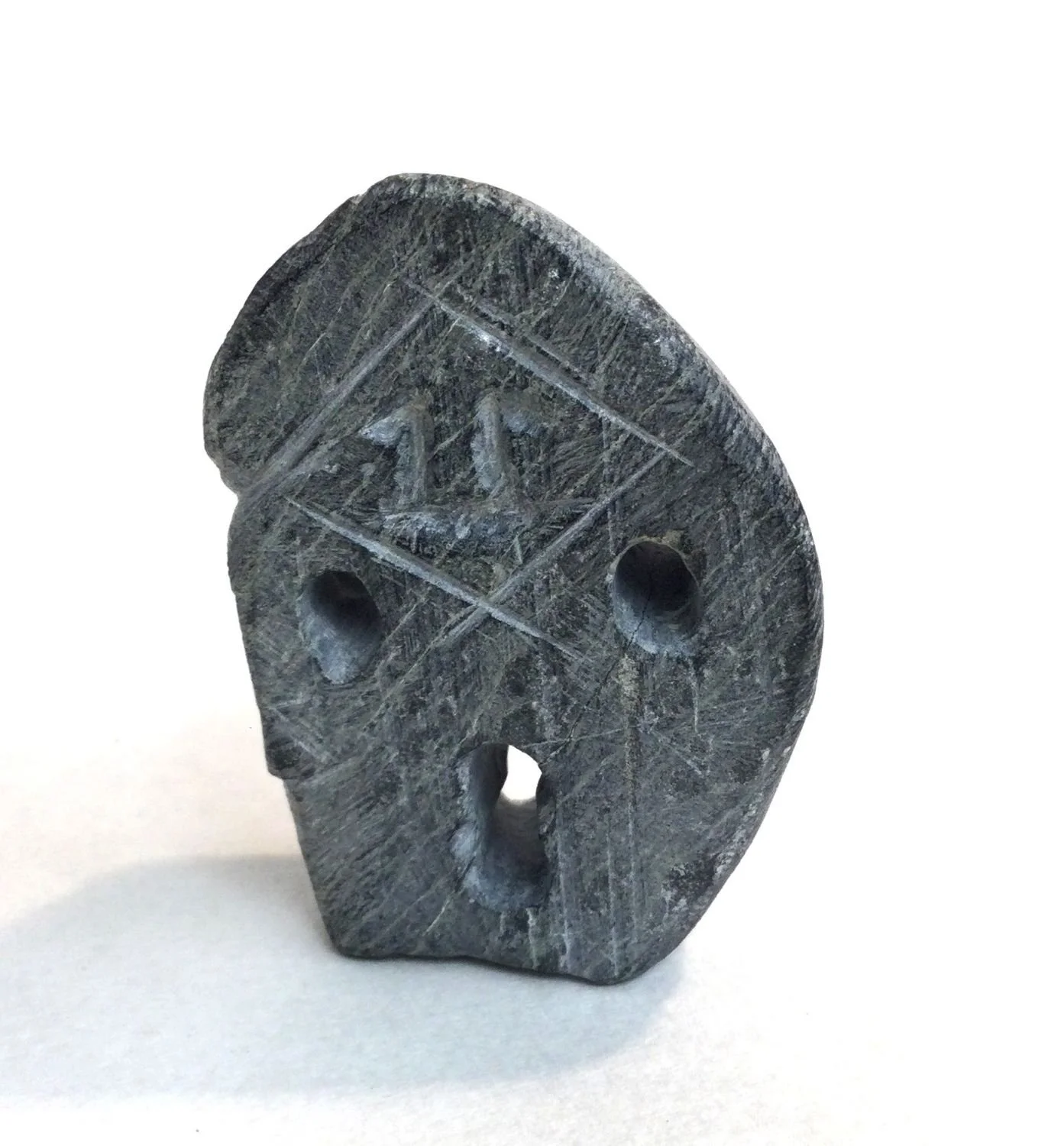
John Kavik (ᔭᓐ ᑲᕕ) E2-290, 1897-1993, Kangiqliniq/Rankin Inlet ᑲᖏᕿᓂᖅ, Standing Figure, mid-1970s, steatite/serpentine, 2.5 x 1.75 x 1 inches (6.5 x 4.5 x 2.5 cm), provenance: private collection BC, $1200 Cdn.

John Kavik (ᔭᓐ ᑲᕕ) E2-290, 1897-1993, Kangiqliniq/Rankin Inlet ᑲᖏᕿᓂᖅ, Standing Figure, mid-1970s, steatite/serpentine, 3.5 x 2.25 x 1 inches (9 x 5.5 x 2.25 cm), $1200 Cdn.
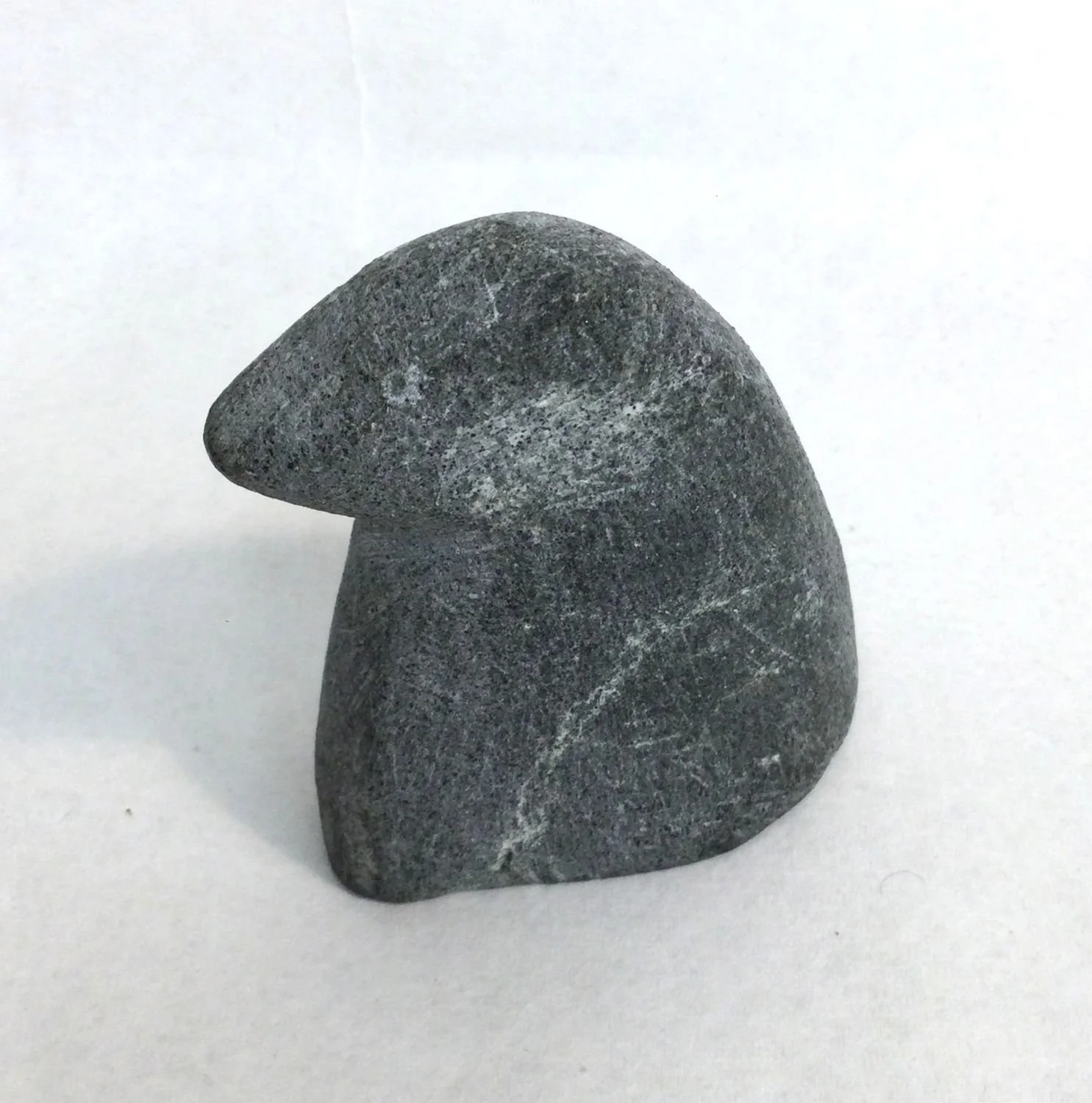
Andy Miki, Arviat/Eskimo Point ᐊᕐᕕᐊᑦ, n.d., serpentine, 2.25 x 2 x 1.25 inches (6 x 5 x 3 cm), provenance: private collection BC, $475 Cdn.
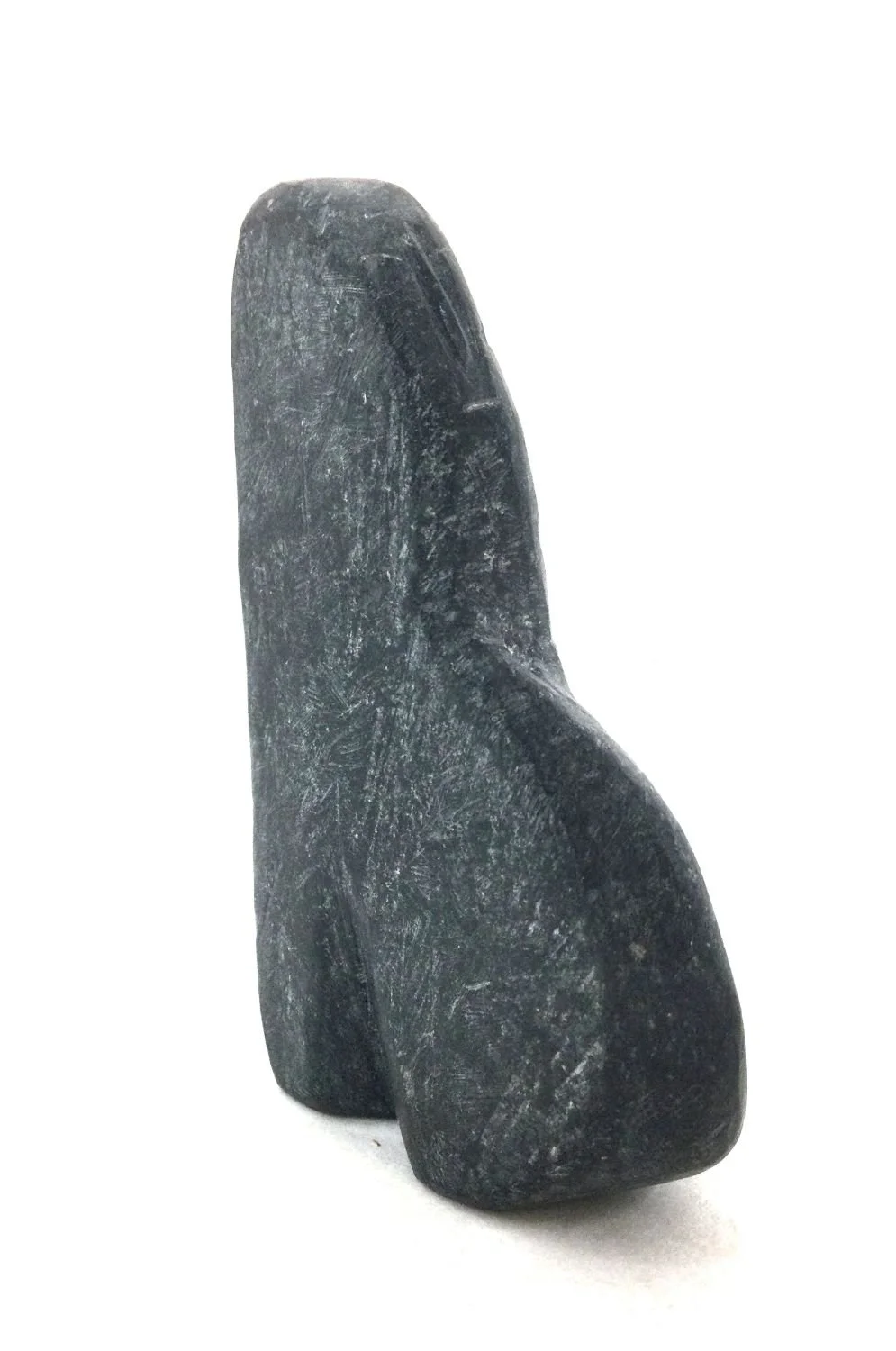
John Pangnark (ᔭᓐ ᐸᓇ) E1-104, 1920-80 Arviat/Eskimo Point ᐊᕐᕕᐊᑦ, Spirit Figure, c.1972, basalt, 2.75 x 1.25 x 1.25 inches (7 x 4 x 3 cm), provenance: private collection BC, $1000 Cdn.
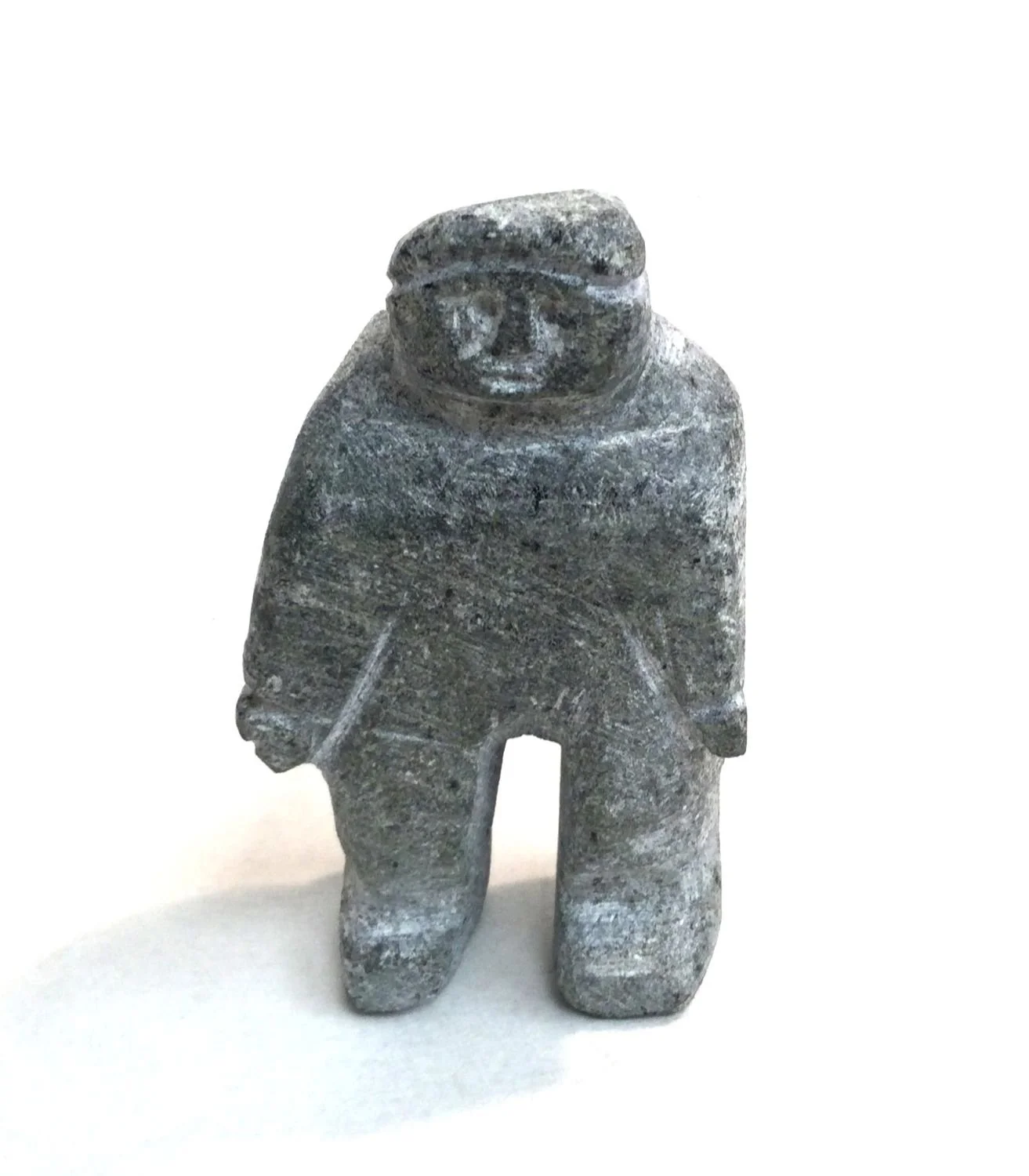
artist unknown (Sugluk/Salluit, Nunavik), n.d., serpentine, 3 x 1.5 x 1 inches (7.5 x 4 x 2.5 cm), provenance: private collection BC, $225 Cdn.
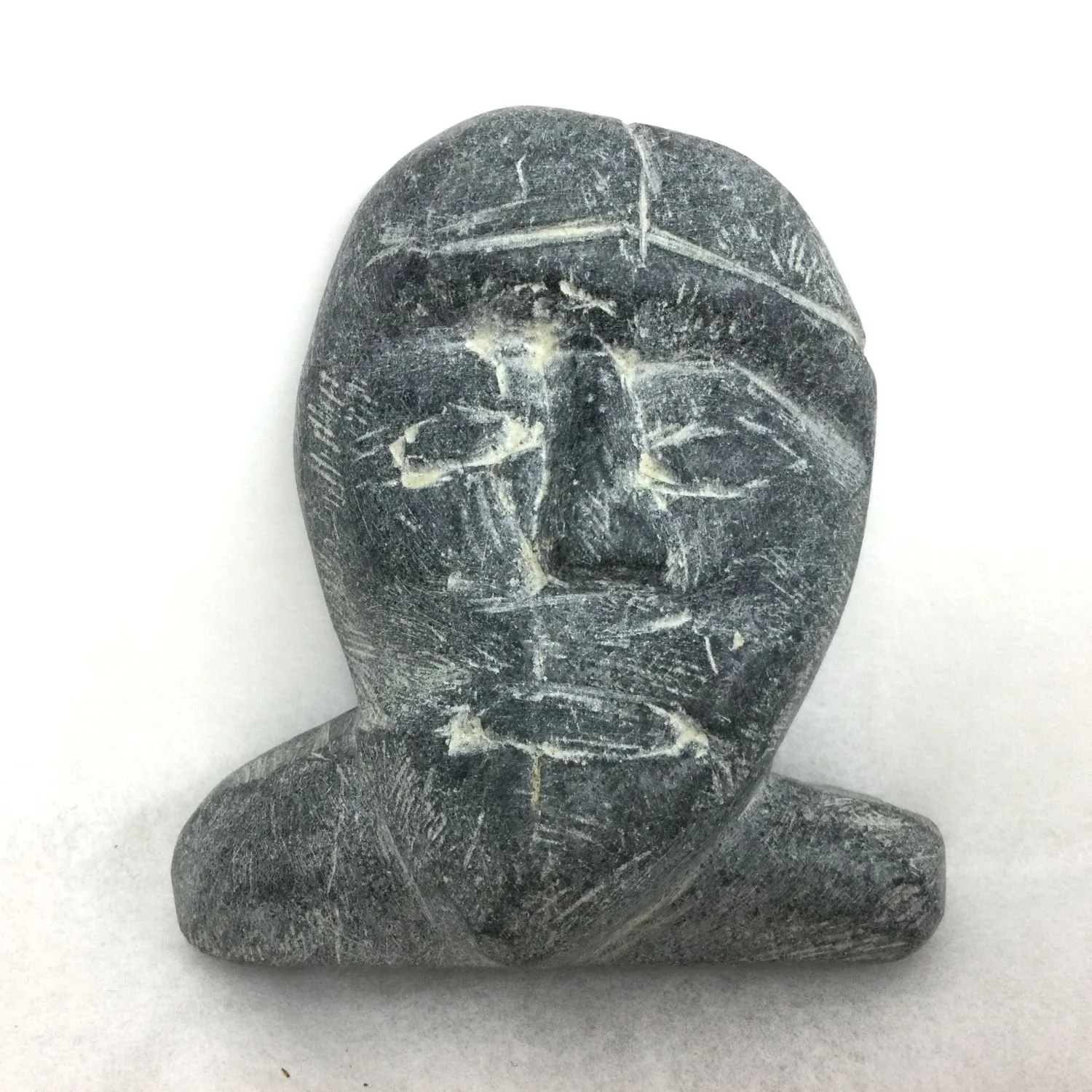
Eli Tikeayak E2-166 (1933-95) Kangiqliniq/Rankin Inlet ᑲᖏᕿᓂᖅ, Small Bust, n.d., steatite/serpentine, 3 x 2.75 x 1 inches (7.5 x 7 x 2.5 cm), provenance: private collection BC, $250 Cdn.
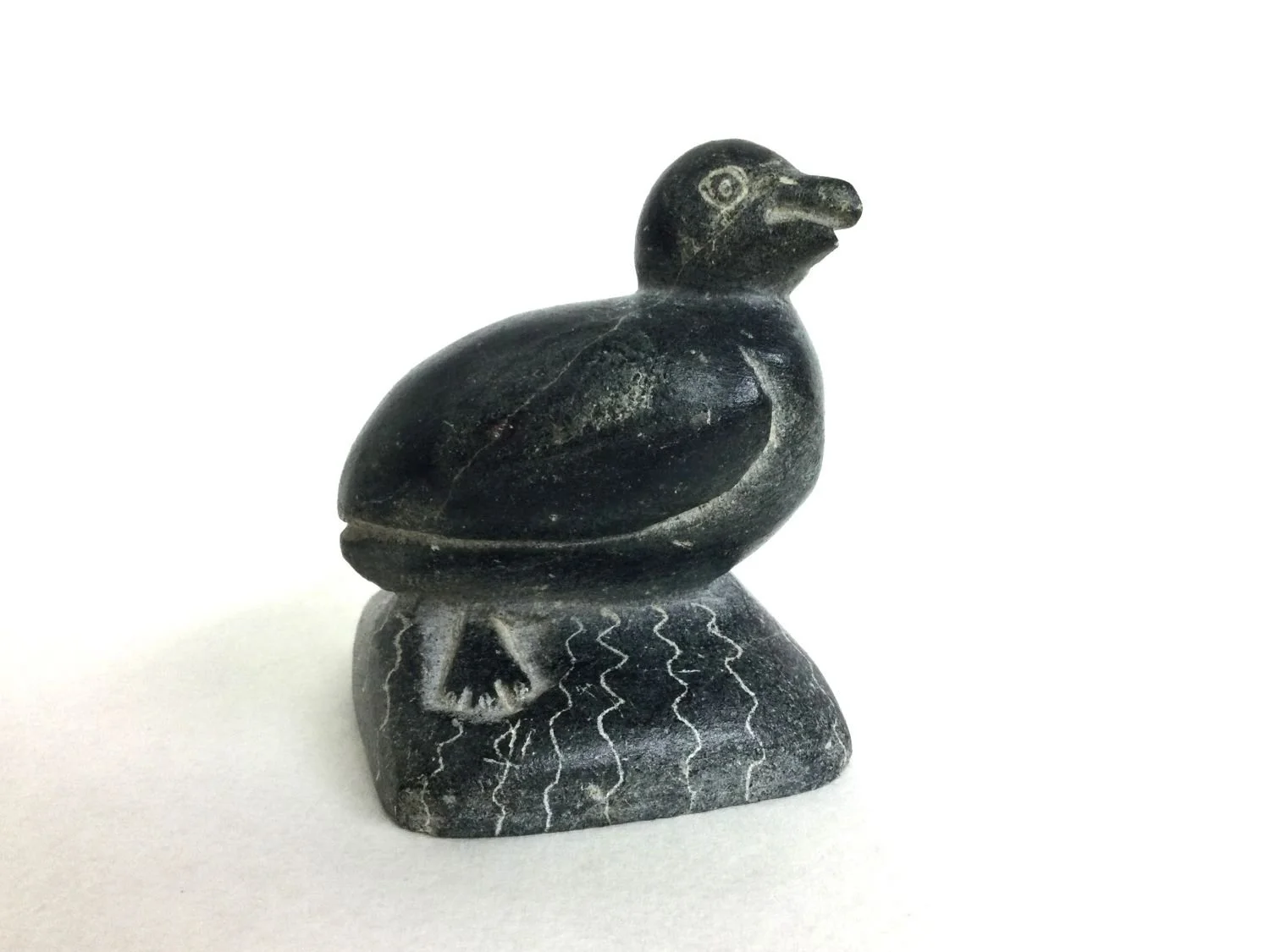
Josie Pappy (Jusi Pamiuttu Papialuk) E9-861 (1918-96) Povungnituk/Puvirnituq (Inuktitut: ᐳᕕᕐᓂᑐᖅ), Sea Bird, n.d., steatite (soapstone), 3x2.25x3 inches (7.5 x 6 x 7.5 cm), provenance: private collection BC, $350 Cdn.
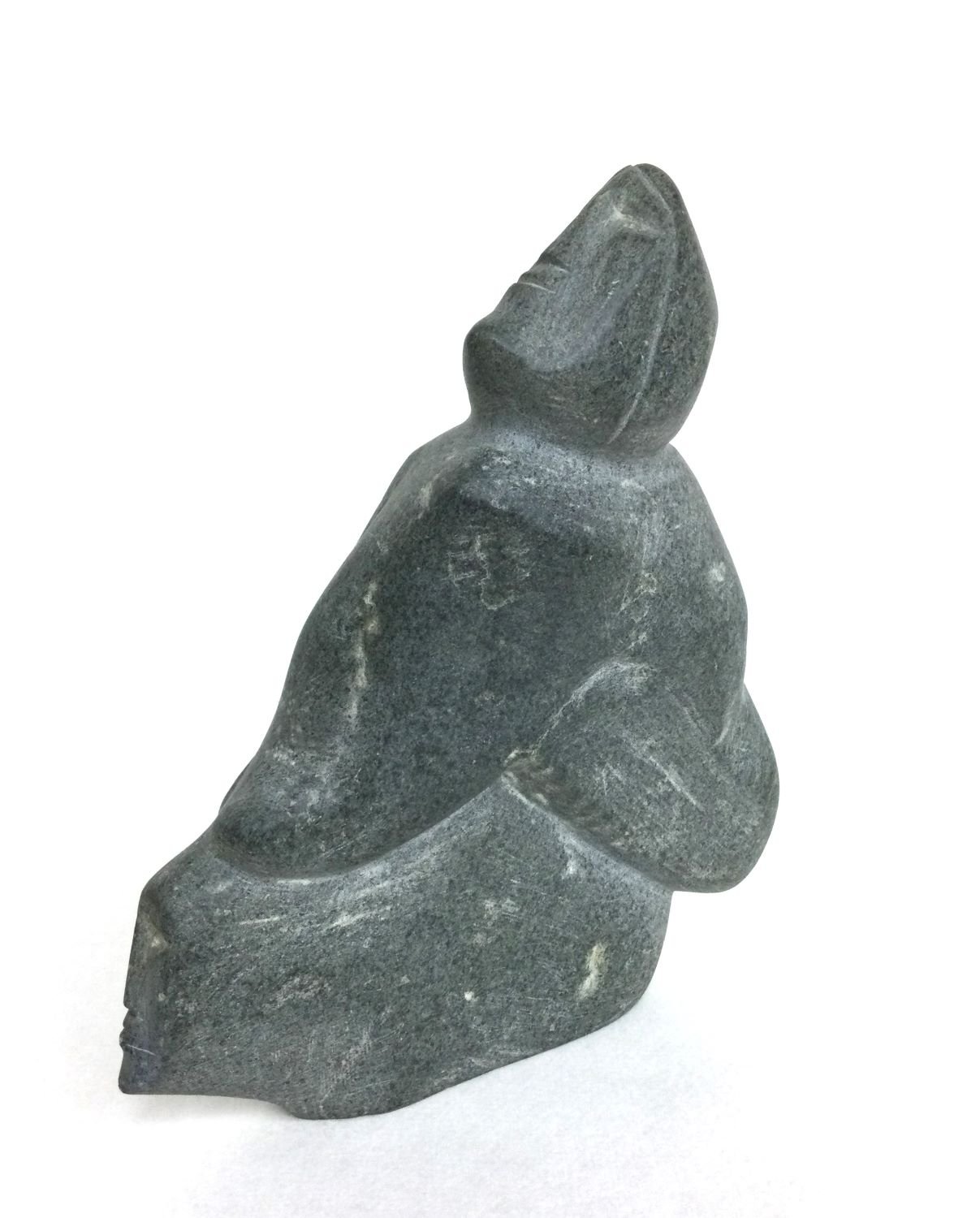
Joy Kiluvigyuak Hallauk E1-366 (1940-2000) Arviat/Eskimo Point ᐊᕐᕕᐊᑦ, Mother And Child, n.d., basalt/serpentine, 8 x 2 x 7 inches (20 x 5 x 17.5), provenance: private collection BC, $1500 Cdn.
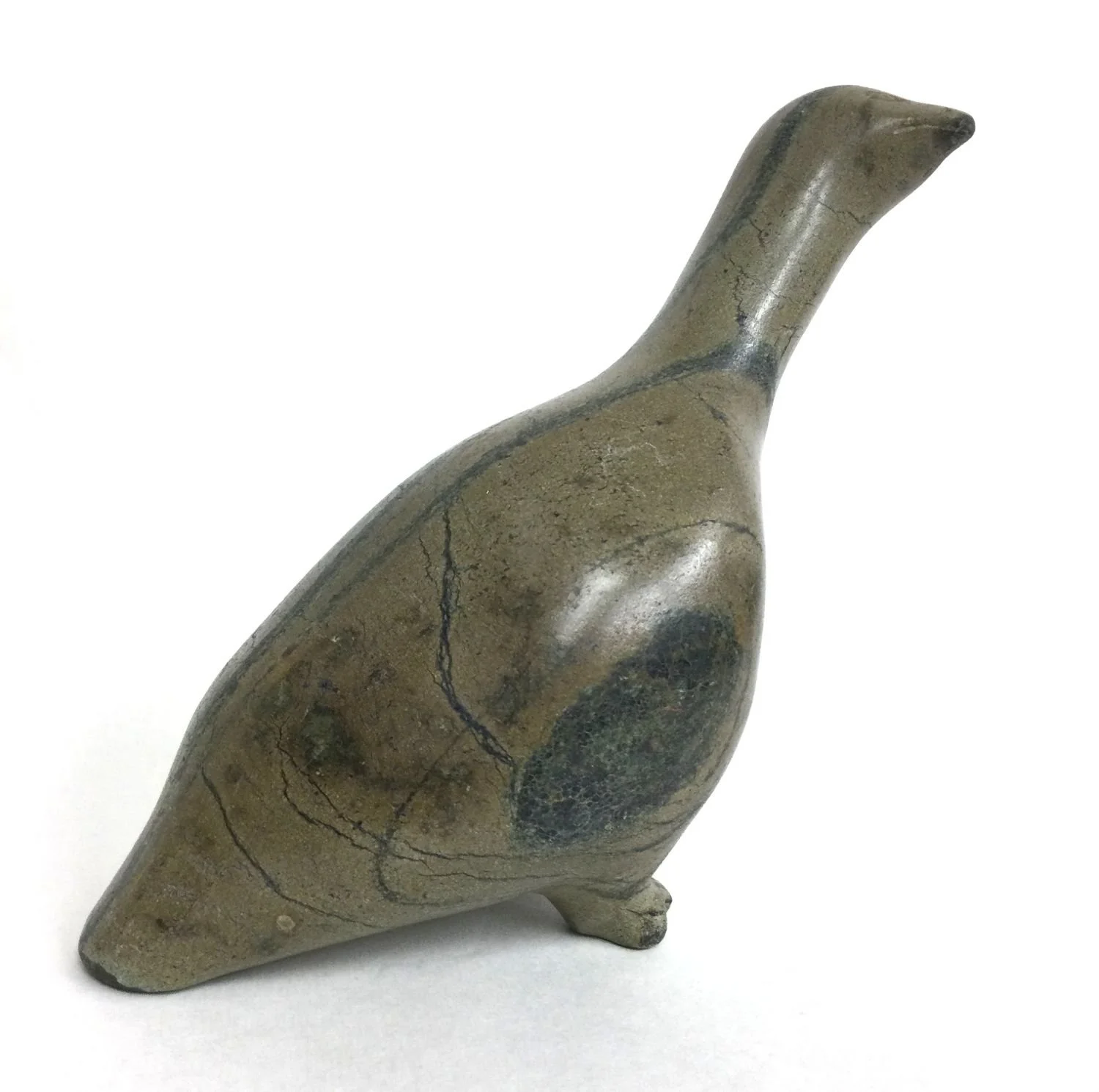
Elisapee Nungusuituq (ᐃᓕᓴᐱ) E7-1145 (1927-85) Kinngait/Cape Dorset, ᑭᙵᐃᑦ, Arctic Bird, n.d. (early), serpentine, 8.25 x 4 x 9 inches (21 x 10 x 23 cm), provenance: private collection BC, $2200 Cdn.
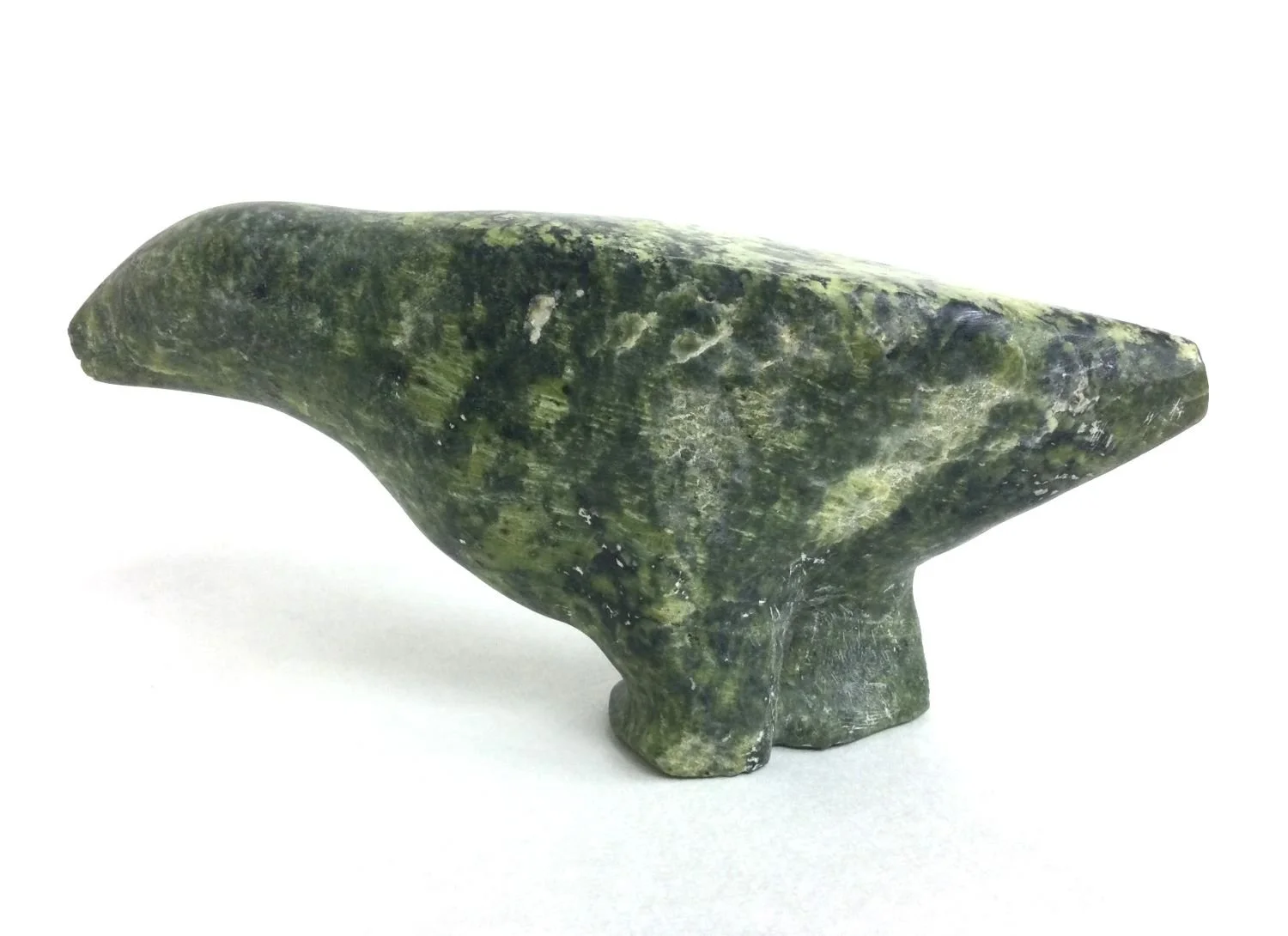
Pauloosie Joanassie E7-1968 (1962-) Kinngait/Cape Dorset, ᑭᙵᐃᑦ, Arctic Bird, n.d. (early), serpentine, 3.75 x 2.5 x 8 inches (9.5 x 6.5 x 20.25), provenance: private collection BC, $425 Cdn.

Mikigak (Mikikgak) Kingwatsiak E7-917 (1943-) (Kinngait/Cape Dorset, ᑭᙵᐃᑦ), Taloolayook (Sedna), c. 1980, green serpentine, 9 x 2.5 x 21.25 inches (23 x 6 x 44 cm), provenance: private collection BC, $2900 Cdn.
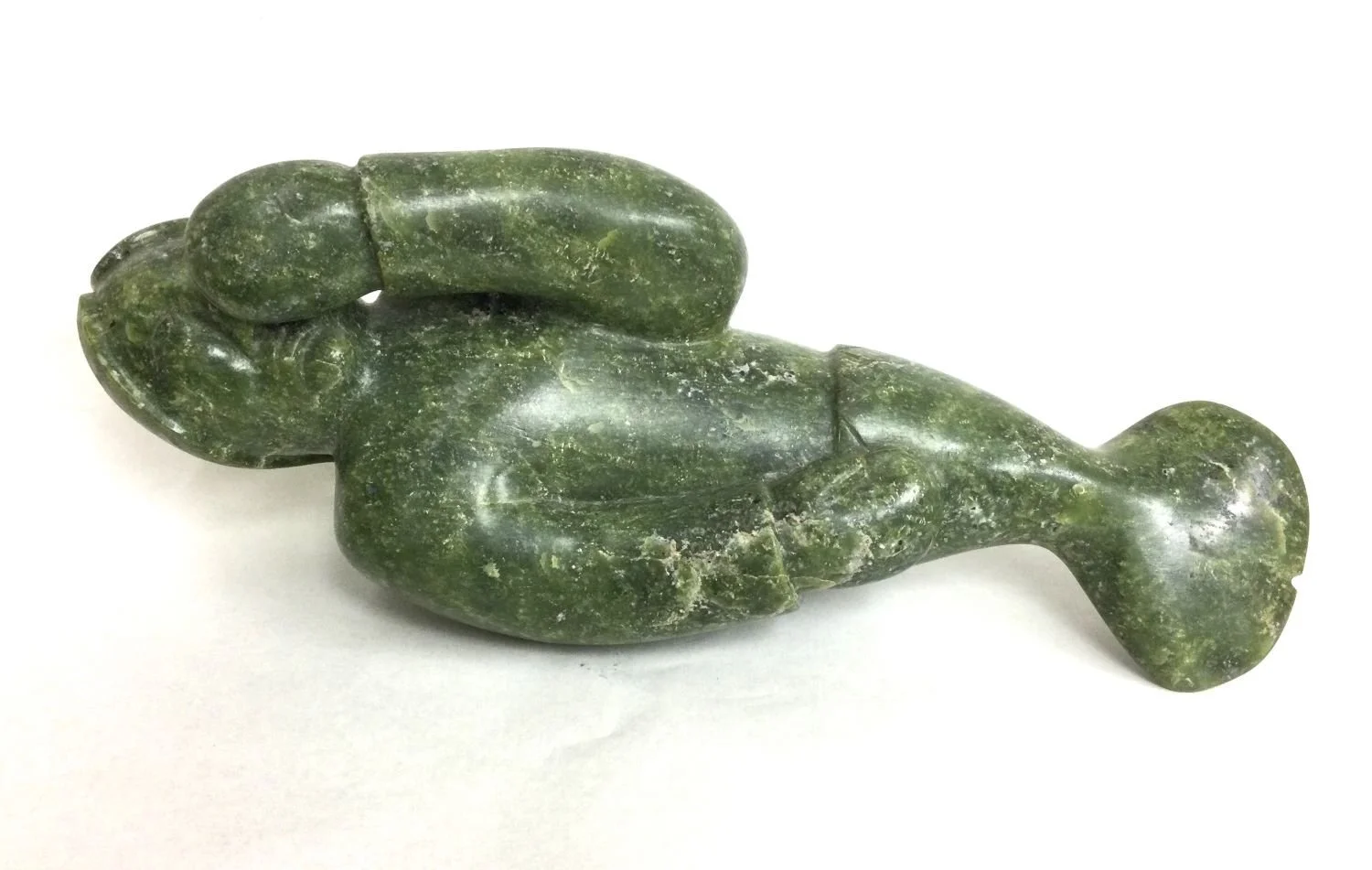
Eyeetsiak Peter, E7-1150 (1937-2011), (Kinngait/Cape Dorset, ᑭᙵᐃᑦ), Taloolayook (Sedna), c.1970, green serpentine, 7 x 5.25 x 20 inches (18 x 13 x 51 cm), provenance: private collection BC, $2700 Cdn.

unknown artist Kinngait/Cape Dorset, ᑭᙵᐃᑦ, Walrus Hunter, n.d., serpentine/steatite (soapstone), 5.5 x 2.75 x 8.5 inches (14 x 7 x 21.5 cm), provenance: private collection BC, $350 Cdn.

Elijassiapik E9-915 (1912-72) Inukjuak/Port Harrison, ᐃᓄᒃᔪᐊᒃ, Diving Walrus, c.mid-1950s, serpentine, 7 x 4.25 x 10.5 inches (17.75 x 11 x 26.5), provenance: private collection BC, $2500 Cdn.

Johnny Akpik, 1958 Iqaluit/Frobisher Bay ᐃᖃᓗᐃᑦ, Seal, n.d., serpentine, 2.5 x 9 x 3 inches (6 x 22.5 x 7.5 cm), $325 Cdn.

James Kingilik (Kingeelik) 1912-75, E2-229; Qamani’tuaq/Baker Lake ᖃᒪᓂᑦᑐᐊᖅ, Antler Bird, 1967, carved antler, 18 x 6 x 12 inches (45.5 x 15 x 30.5 cm), $1500 Cdn.
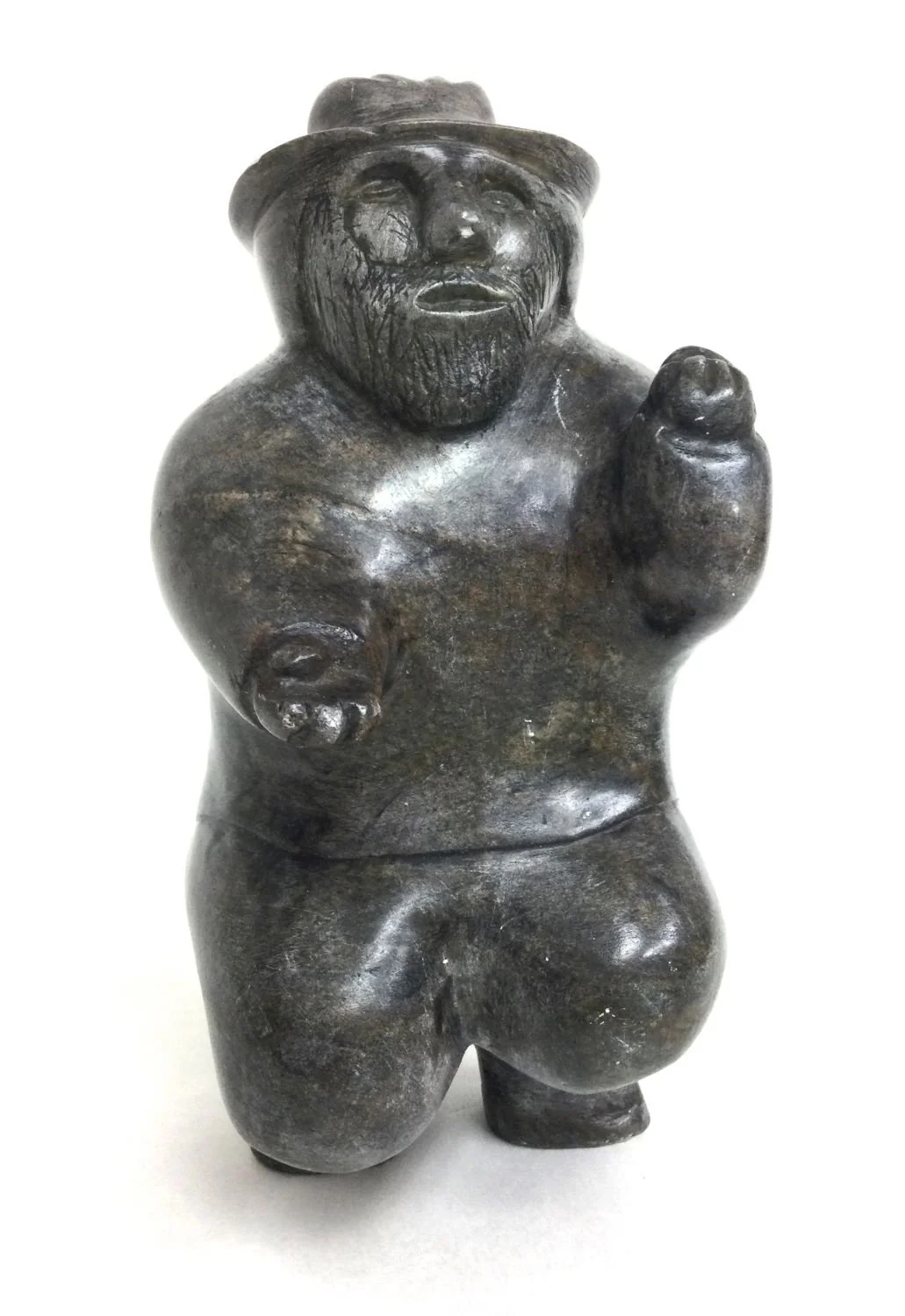
Martha Tickiq (Tickie) E2-128 (1939-2015) Qamani’tuaq/Baker Lake, ᖃᒪᓂᑦᑐᐊᖅ, Dancing Figure, n.d. basalt, 10.25 x 4.5 x 5 inches (26 x 11.5 x 12.5 cm), provenance: private collection BC, $1800 Cdn.

unknown artist, Qamani’tuaq/Baker Lake ᖃᒪᓂᑦᑐᐊᖅ , Arctic Bird, c. 1970s, serpentine, 7 x 5 x 9.25 inches (18 x 12.5 x 23.5 cm), $1500 Cdn.

Annie Ikilluaq Saviakjuk E9-1197, 1938- (Salluit/Suglak, ᓴᓪᓗᐃᑦ, Nunavik), Kneeling Woman Stretching A Skin, early 1950s, serpentine, 8 x 4 x 5.75 inches (20 x 10 x 14.5 cm), $2500 Cdn.
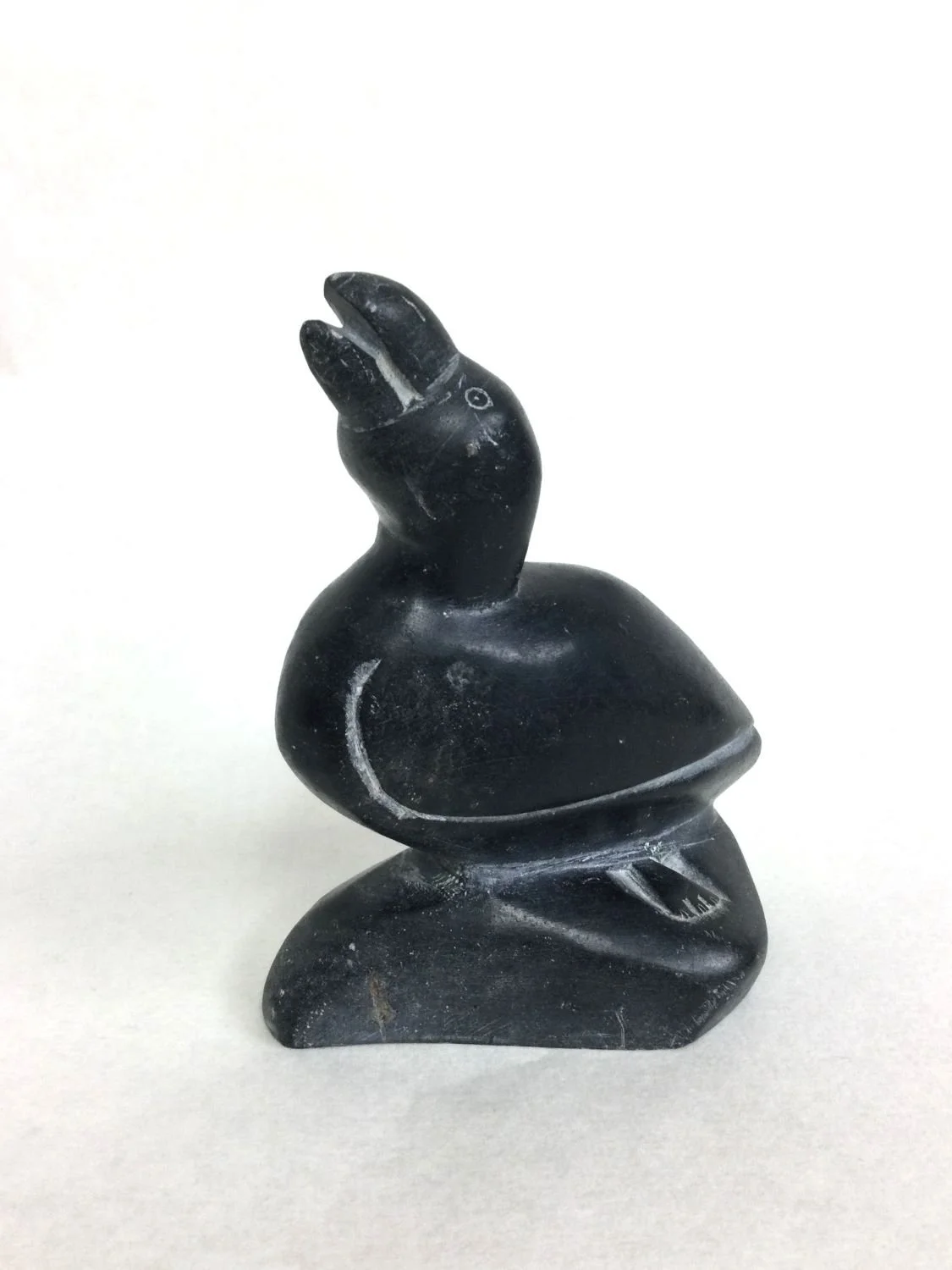
Josie Pappy (Jusi Pamiuttu Papialuk) E9-861 (1918-96) Povungnituk/Puvirnituq (Inuktitut: ᐳᕕᕐᓂᑐᖅ), Sea Bird, n.d., steatite (soapstone), 4.75 x 2.25 x 4 inches (12 x 5.5 x 10 cm), provenance: private collection BC, sold.

Johnny Aculiak (Inukjuak-Port Harrison), Seal, 1987, steatite (soapstone), 5 x 8.5 x 2 inches, Provenance: private collection Calgary; sold.

Bertha Anauta, 1933- (Puvirnituq), Sea Bird, c. late 1960s, steatite (soapstone), 3.25 x 4.5 x 1.75 inches, Provenance: private collection Calgary; sold.

Norman Qumuaqtuq (1948-2014) (Pangnirtung/Pangnirtuq), Hunter Packing His Cache, 1975, steatite (soapstone), 2.5 x 3.5 x 2.5 inches, Provenance: private collection Calgary; sold

Allie Niviaxie (Inukjuak-Port Harrison), Hunter With Fox, steatite (soapstone), 6 x 5.5 x 2.5 inches, Provenance: private collection Calgary; sold.

Seepee Ipeelie (ᓯᐱ ᐃᐱᓕ) E7-511 (1940-2000), Iqaluit/Frobisher Bay ᐃᖃᓗᐃᑦ, Arctic Goose, n.d., green serpentine (two pieces), 8.75 x 5 x 10 inches (22 x 12.5 x 25.5 cm), provenance: private collection BC, sold.

Jimmie (Jimmy) Petalassie (Petaulassie/Petauloosie), 1961-, (Kinngait/Cape Dorset, ᑭᙵᐃᑦ), Polar Bear, n.d., serpentine, 5 x 3.25 x 8.5 inches (12.5 x 8.5 x 21.5 cm), provenance: private collection BC, sold.
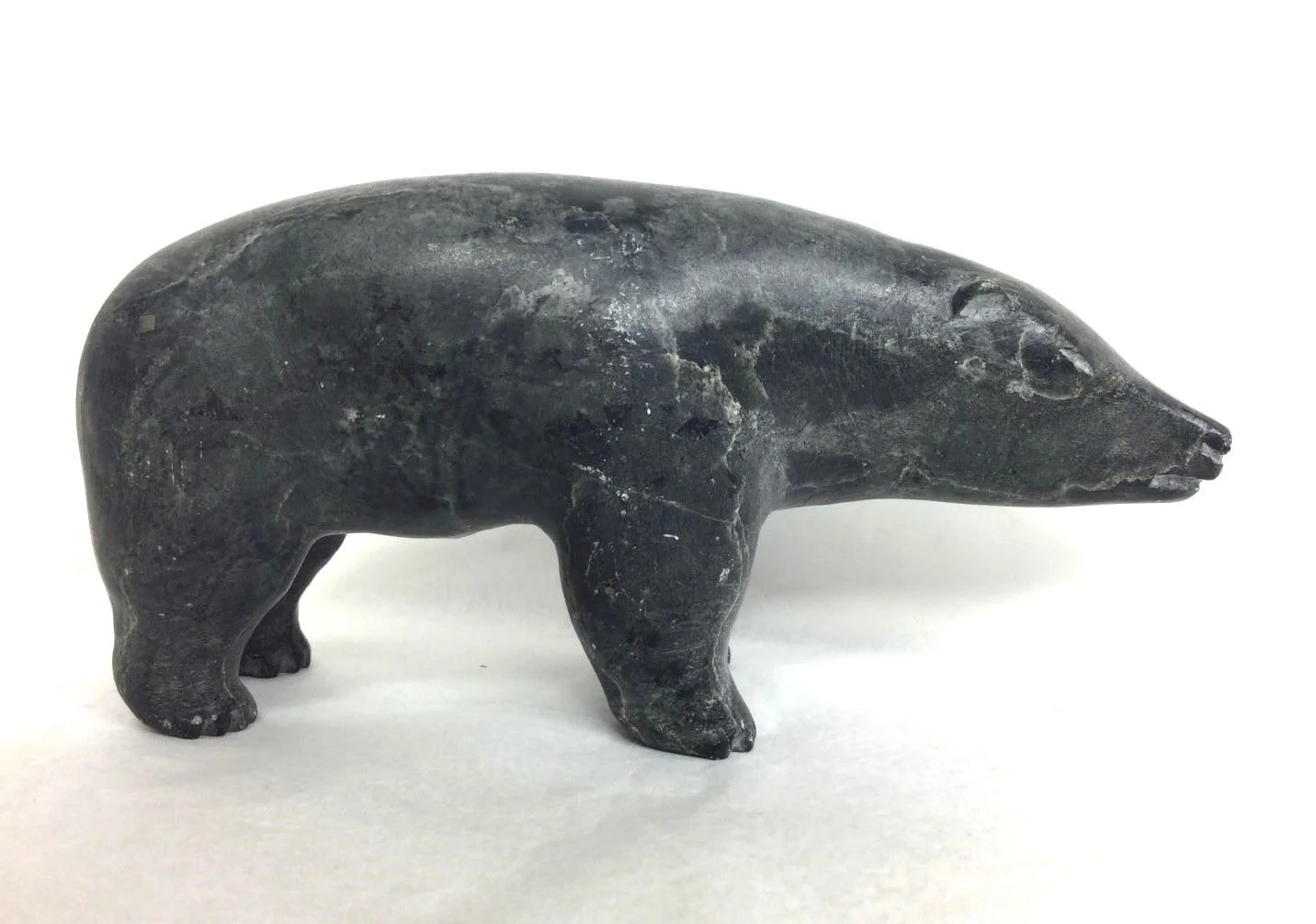
artist unknown (Kugluktuk/Coppermine, ᖁᕐᓗᖅᑐᖅ), Bear, n.d., steatite (soapstone), 3.25 x 2 x 6.25 inches (8.25 x 5 x 16 cm), provenance: private collection BC, sold.

artist unknown (Sugluk/Salluit, Nunavik), n.d., steatite (soapstone), 2.75 x 1.75 x 1.25 inches (7 x 4.25 x 3 cm), sold.
“Carving…is something which Inuit do to earn their living and to show the world what kind of people they are…showing what is true….”
(Marybelle Myers, “In The Wake Of The Giant” in Blodgett, 18).
This collection showcases the remarkable depth and diversity of historic Inuit sculpture, featuring works by both recognized and anonymous artists. Together, these pieces reveal a tradition defined by expressive beauty, sensitivity, and strength.
Inuit sculptors, regardless of their region, share a profound respect for strong form, balanced volume, and the simplicity of line. They approach each stone with an awareness of its inherent character, seeking to harmonize its natural qualities with the vision of the creature or spirit within. Every stone carries its own message, and through skill and intuition, the sculptor reveals its inner form.
The result is a collection that not only celebrates the uniqueness of Inuit carving but also embodies its enduring vitality and artistry.
The collection draws from many settlements across the Canadian Arctic, each with its own distinctive carving stone and traditions.
Inukjuak, meaning “Giant” in Inuktitut, lies on the eastern shore of Hudson Bay. Artists here work with steatite and serpentine quarried 40 miles from the village. These stones allow for smooth carving and reveal the sculptor’s sensitivity to the material’s natural flow.
Cape Dorset is renowned for its serpentine, ranging in color from light yellow-green to deep black. Though hard, it rewards skilled hands with the ability to create bold yet delicate lines and glistening, elegant finishes.
Iqaluit, “the place of many fish,” is near the Sylvia Grinnell River. Local sculptors have long carved the region’s stone into works that balance strong form with cultural expression, carrying forward traditions rooted in the land.
Puvirnituq, on Hudson Bay, is known for early works in fine-grained black argillite and locally quarried steatite. Sculptors often focus on traditional subjects, like birds, rendered with graceful clarity and carefully incised details that convey both form and spirit.
Salluit/Sugluk artists historically worked steatite to create scenes of survival—hunting, life, and resilience in the Arctic. The community stands out for the contributions of women carvers, whose works added unique voices to the region’s artistic legacy.
Together, these stones—serpentine, steatite, argillite—carry the stories of their landscapes, shaped by sculptors who reveal both the strength of their traditions and the inner life of the material itself.
Bibliography.
Barz, Sandra B. Inuit Artists Print Workbook Volume I. New York: Arts & Culture of the North, 1981.
________. Inuit Artists Print Workshop Volume II. New York: Arts & Culture of the North, 1990.
Blodgett, Jean., Myers, Marybelle., Houston, James. Port Harrison/Inoucdjouac. Winnipeg: The Winnipeg Art Gallery, 1976.
________. Povungniuk. Winnipeg: The Winnipeg Art Gallery, 1977.
Blodgett, Jean. Three Women, Three Generations. Drawings by Pitseolak Ashoona, Napatchie Pootoogook and Shuvina Ashoona. McMichael Canadian Art Foundation, Ontario, 1999.
Dorset Fine Arts. Art Of Cape Dorset. Toronto: Dorset Fine Arts, 2016.
Driscoll, Bernadette, Ed Horn, Patricia Sieber. Baker Lake, Prints & Print-Drawings 1970-76. Winnipeg: Winnipeg Art Gallery, 1982.
________. Belcher Islands/Sanikiluaq. Winnipeg: The Winnipeg Art Gallery, 1981.
________. Uumajut, Animal Imagery In Inuit Art. Winnipeg: The Winnipeg Art Gallery, 1985.
Evrard, Marcel. Masterpieces Of Indian and Eskimo Art From Canada. Paris: Friends Of the Museum of Man Society, 1969.
Goertz, Helga. The Inuit Print. Ottawa: National Museum of Man, 1977.
Government of Canada. Inuit Art Section: Catalogue of Services and Collections. Ottawa: Indian & Northern Affairs Canada, 1984.
Hessel, Ingo. Inuit Art, An Introduction. Vancouver: Douglas & McIntyre, 1998.
Houston, James A. Eskimo Prints. Barre, MA.: Barre Publishers, 1967.
LaBarge, Dorothy. From Drawing to Print, Perception and Process in Cape Dorset Art. Calgary: Glenbow Museum, 1968.
Masters of Indian and Eskimo art from Canada. National Gallery Of Canada, Paris, 1970.
McMaster, Gerald, ed. Inuit Modern. Toronto: Art Gallery of Ontario, 2010 and DM Publishers, Vancouver. Art Gallery Ontario, 2011.
Meldgaard, Jorgen. Eskimo Sculpture. London, England: Methuen & Co. Ltd., 1960.
Mitchell, Marybelle. Inuit Art Quarterly, Summer 1991.Vol 6, no.3. Inuit Art Foundation.
Mitchell, Marybelle. Inuit Art Quarterly, Summer 2001.Vol 6, no.2. Inuit Art Foundation.
Norton, Derek and Nigel Reading. Cape Dorset Sculpture. Vancouver/Seattle WA: Douglas & McIntyre and University of Washington Press, 2005.
Oakes, Jill and Rick Riewe. Our Boots / An Inuit Women’s Art. Vancouver/Toronto: Douglas & McIntyre, 1995.
Pilon, Jean-Luc. First Peoples Of Canada: Masterworks From The Canadian Museum Of Civilization. Toronto: University of Toronto Press, 2013, p. 94-121.
Routledge, Marie. Inuit Art In The 1970s. Kingston: Agnes Etherington Art Centre, 1979.
Swinton, George. Eskimo Sculpture/Sculpture Esquimaude. Toronto: McClelland & Stewart Ltd., 1965.
________. Sculpture of The Eskimo. Toronto: McClelland & Stewart, 1972.
Vladykov Fisher, Kyra. Guide To Cape Dorset Artists. Cape Dorset: Municipality of Cape Dorset, 2008; republished Dorset Fine Arts, Cape Dorset, 2016.
Wight, Darlene. Creation and Transformation, Defining Moments In Inuit Art. Vancouver: Douglas & McIntyre/Winnipeg Art Gallery, 2012.
________ . Holman, Forty Years of Graphic Art. Winnipeg: Winnipeg Art Gallery, 2001.
Wigmore, Donnalu ed. Isaacs Seen 50 years On The Art Front, A Gallery Scrapbook. Toronto: University of Toronto, 2005.
Zepp, Norman. The Rose Collection Of Inuit Sculpture. Regina, SK: Norman Mackenzie Art Gallery, University of Regina, 1983.
